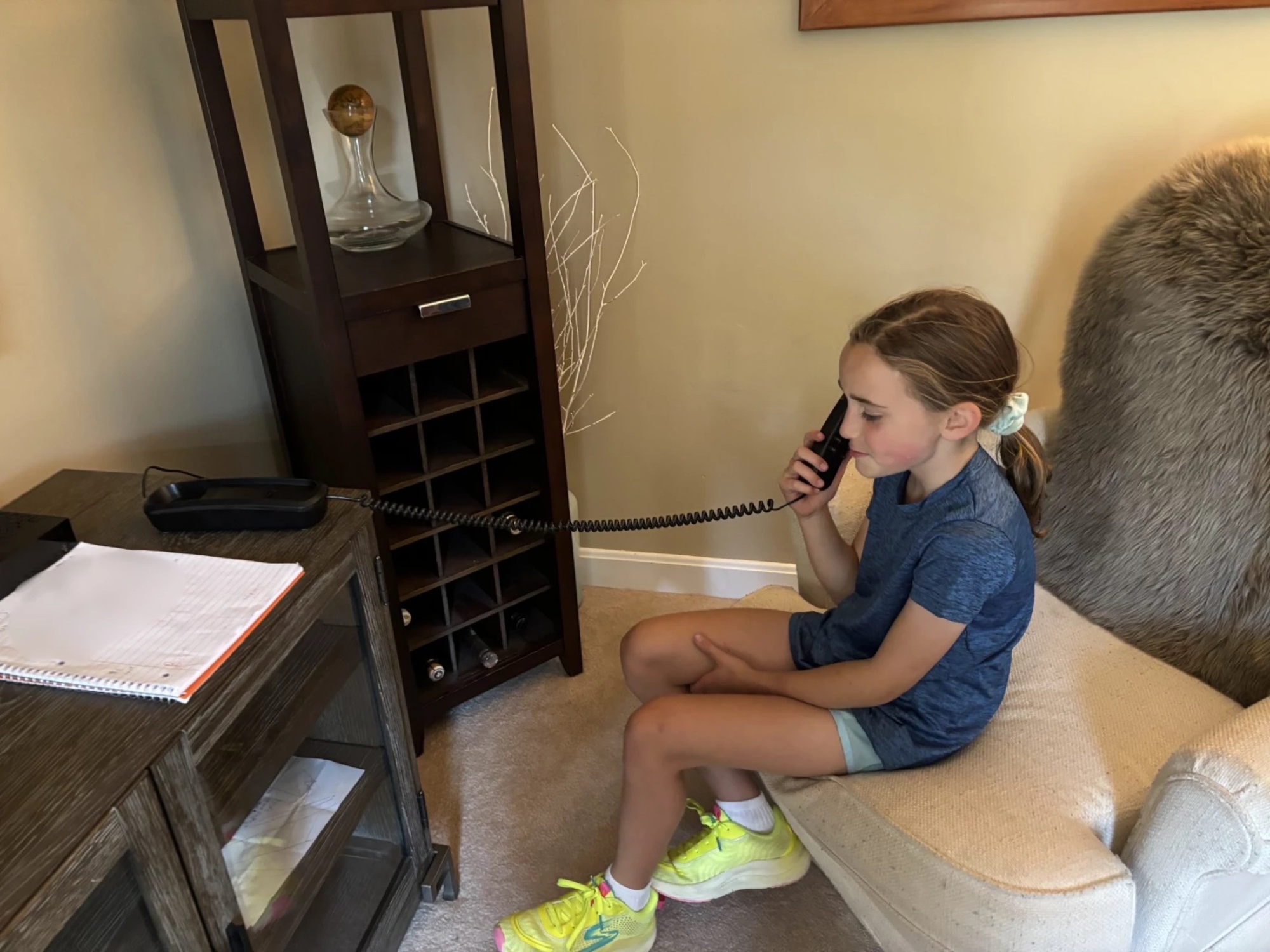
Standing in the kitchen of her South Portland home, 8-year old Piper Morse picked up a phone to call a friend.
“Hi, Carly. Whatcha doin?” Piper asked.
The two have a lot to discuss: soccer game scores, an upcoming bake sale and the latest on the social scene.
“I’ll see you at the party,” Piper said.
The conversation may be typical for a third-grader, but the phone connection is not. Piper was cradling a white plastic handset to her ear. It’s connected by a long spiral cord to a base with a push-button dial pad. It’s just … a phone.
“I like it because you don’t have to look on a screen and there’s buttons,” Piper said.
By the age of 8, nearly a quarter of U.S. children own a cellphone — and most are smartphones with apps and internet access. For many parents, giving a child their own smartphone is a fraught milestone. But some are finding ways to avoid its pitfalls and still keep their pre-teens connected to friends. They’re getting landlines.
Piper’s sister Molly, who’s 10, also likes the landline. She’s puzzled by the way that kids on the school bus pull out their smartphones and ignore each other.
“Because people are sitting next to them, who’s their friends and stuff,” Molly said. “And I’m like, put your phone down and just talk to people next to you.”
Molly and Piper’s mom, Caron Morse, said getting a landline “is probably the smartest parenting move I’ve made.”
Morse was dreading the day when her daughters would own smartphones. As a social worker at an elementary school, Morse sees firsthand the way that smartphones can expose kids to inappropriate content, online bullying and monopolize their attention.
“There definitely is a cellphone addiction in children right now,” Morse said.
As Morse worried about what to do, she thought about the phone she used growing up and wondered if her kids would embrace a landline. But for them to go along with the idea, she thought she’d need other families to do the same and started nudging neighbors and friends.
“Get a landline with us,” Morse said she would tell them. “Join us. It’s not that complicated. It’s not that expensive.”
Now, a year later, Morse said about two dozen families in her community have landlines — or internet phones that essentially function like a landline. And she’s seen unexpected benefits. Morse says her daughters are better at conversations. They’re not distracted like they were when they used her smartphone to call friends.
“They took my cellphone and they would disappear, and there would be filters, and their voice would turn into, you know, like a robot,” Morse said. “I don’t even think they were talking, you know? I don’t think that they were actually learning how to communicate.”
Morse said she and other parents were so happy with their landlines, they launched a Landline Kids website to encourage others to do the same.
“Hello?” 11-year-old Ashton Ladd of Scarborough said as he called his friend Parker.
“I was wondering if you wanted to go fishing,” Ashton asked. He’s been using a landline since last spring.
“Once we get off the bus from school, we were kind of just isolated from all of our friends,” he said. “But now that we have this, we’re not really anymore.”
His mom, Jen Ladd, said she and her husband wanted to stay in touch with Ashton and his 9-year old sister, Claire, as they got older and were home alone from time to time. She liked the landline option because its focus is outward for calling family and friends and making plans.
“As opposed to just sitting on their phone by themselves and doing who, you know, who knows what,” Ladd said, “internet surfing or any number of other things that are just a little bit more secluded.”
David Bickham, research director at the Digital Wellness Lab at Boston Children’s Hospital, said that smartphone are powerful devices “that can really open the world to a huge amount of information and content and people that are both positive and negative.”
Smartphones can foster connection, he says. But they can also contribute to loneliness and mental health issues. The key, Bickham said is, to be thoughtful and intentional about their use.
“What’s really challenging about it is, how do I set it up so that it’s not controlling me? I’m in control of it,” he said.
Bickham recommends parents to use settings that will encourage healthy use. Turn off notifications. Require permission to download an app. Explain why these controls are important.
There’s no one ideal age to get a smartphone, he said, but “pushing it past that 9,10, age, which is really starting to be the most common age that young people get phones, to be pushing it beyond that as much as possible, I think it’s probably fairly useful for kids,” Bickham said.
In the meantime, he said, a landline is a viable option.
Jen Ladd said her kids have learned skills from the landline that she hadn’t expected.
“It’s fun,” she said. “It’s an independent thing for them to be able to do, to sort of like, reach out to someone and make a plan, or not. My daughter calls her friends and they tell jokes to each other.”
Sitting in a living room chair, Claire Ladd dialed her friend Ellie to share her latest joke.
“Why is the toilet paper afraid to cross the road?” Claire said.
“Why?” Ellie asked.
“Because he was afraid he’d get stuck in the cracks,” Claire answered, as they erupt into giggles.
What’s an easy way to delay getting a smartphone? For these parents, the answer to that riddle is to get a landline.



